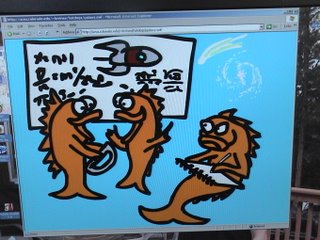
My daughter is very creative and sometimes shows her true feelings in her art.
While she is graduating with 3 majors, Fine Arts, Music and Japanese; I got the feeling from this picture that she was feeling bad that she didn't choose Astro Physics or Astronomy as one of her majors. She has been really showing alot of interest in this direction and has been working in the astrophysics building with folks that work with NASA and such. Constantly talking about all of the cool stuff that she does while there working. So I was feeling bad that she didn't learn that she was interested in this until after 7 years of college.
Then she started her Honors program and thesis this past year. It's simply incredible how she managed to put all of this scientific work into a beautiful art form, blending together her art with science. Her gallery opening was April 7th, and was a big success. It was very well attended, and I am just so very proud of her. Below is a photo of her 'Spectral Beasties' art show.

Solar Spectrum and Absorption Beasties
Acrylic on foam
What do you get when you look at a rainbow in detail? You begin to see it interrupted by dark bands. These bands are caused when the light is absorbed by molecules and elements present between the hot part of the sun and our eyes, some found in the earth’s atmosphere, some found in sun’s atmosphere. The most prominent bands were first classified by German physicist Joseph von Fraunhofer in the 19th century with the letters H through K, some of which are illustrated here by being orally absorbed by beasties. Each element and molecule absorbs only a very specific frequency of light, which tells us what the sun is composed of.
This painting spans the visible segment of the electromagnetic spectrum (roughly 400-700 nm), which also includes radio waves, microwaves, infrared radiation, ultraviolet radiation, x-rays, and gamma rays. The sun’s light is strongest in the visible part of the spectrum, which may be why our eyes have adapted to see it best.
Emission Beasties of Selected Elements
Acrylic on canvas
These beasties lie near the floor in their ground state. When an atom loses energy it emits a photon. The photons emitted show up in bright bands against a dark background in exactly the same positions that they appear in when absorbing light. Scientists can compare the spectrums of known gases with those of unknown elements in spectrums of celestial objects, such as the sun, in order to understand their compositions. Can you match the absorbed twin D lines in the solar spectrum above, to the emitted twin yellow lines in one of these paintings?
The five paintings exhibit emission spectra of five elements (from left to right):
Na – Sodium, found in trace amounts in the sun
He – Helium, composing 8% of the sun
H – Hydrogen, composing 92% of the sun
O2 – Oxygen, largely in the earth’s atmosphere, also found in trace amounts in the sun
Hg – Mercury, found in trace amounts in the sun
K 393nm Ca
H 397nm Ca
E 527nm Fe
D1 and D2 doublet 589nm and 590nm Na
B 688nm O2 (earth’s atmosphere)
Doppler Fishes
Oil on canvas
When a train approaches, the pitch of its whistle seems high and then when it passes the pitch drops. This is because the whistle’s sound waves are getting squished together as the train comes towards you, and stretched out as it moves away.
The same thing happens with light. As a light source in space such as the Andromeda Galaxy moves towards us, its light waves get compressed and the patterns in its spectral lines all get shifted towards the blue end of the spectrum. The opposite thing happens to nearly all other celestial objects: they are red-shifted because they are moving away. Due to red-shift we can tell the universe is expanding.
So as you can see, she has learned how to incorporate science into an art form. There is simply nothing that she can't do, I'm convinced of this.

No comments:
Post a Comment